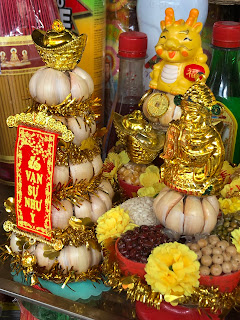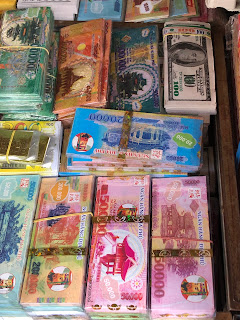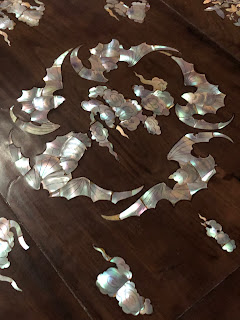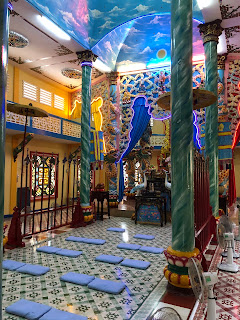 |
| The bus driver's compartment |
 |
| Travelling to the Mekong River |
In the morning, the group of about 100 on the tour were bussed to the the port town of
My Tho, predominantly a fishing village.
When we arrived at the ship, we were surprised to the the large amount of water hyacinths clogging the side of the river. At this point the Mekong is very wide and flows slowly.
After boarding the ship and settling in to the quite spacious cabins, the ship headed upstream towards Cai Be to anchor overnight. The river was quite brown from silt carried down from upstream which provides the fertile soil along the flood plain - I can't see how fish find their way in this brown soup.
 |
| Waiting to board the ship |
 |
| Water hyacinths |
 |
| The MV Amalotus |
 |
| Tai chi on board |
 |
| Tai chi on board |
This was the first day of the cruise, and I had previously arranged with Luc, the cruise director, to run a Tai Chi class for passengers at 6:30am in the lounge area. It was early, because there was a planned excursion for the morning.
Surprisingly, about 14 people turned up for the class, some of which had done a little Tai Chi before. The area was only just big enough but we had a good qigong practice with Frances helping with the demonstration. We eventually did it every day of the cruise.
After breakfast, the passengers transferred into 3 motorised sampans for an excursion along waterways to the town of Cai Be.
 |
| Travelling in the sampan |
 |
| Buildings along the river |
 |
| Many small fishing boats |
Our first stop was at a family business which specialised in producing rice wine infused with snake venom.
The straight rice wine, had not much taste or flavour, but the one that had a small amount of snake venom, which came from a large jar containing numerous snakes, had much more flavour. The alcohol content is generally over 30%.
As we walked along the shoreline to the next business, we passed pieces of jackfruit being dried in the sun.
 |
| The distillation process |
 |
| A "cobra cocktail" |
 |
| Snake-infused alcohol |
 |
| Making sheets of rice paper |
The second family produced not only similar type of wine, but also produced rice paper for wraps, popped rice and coconut flavoured sweets.
For popped rice, rice husks are burned in a furnace to heat the pan which has river sand (which turns black during the heating process) and the rice grains are tipped on top and as the mixture is stirred, the rice begins to pop.
The popped rice and sand is scooped out and sifted in two stages leaving the popped rice.
This product used in various ways, but mainly mixed with cane sugar and the mixture is then rolled out, sliced up and bagged to be eaten as a snack, often on farms because it provides energy plus a feeling of fullness to reduce the pangs of hunger.
 |
| Cutting up the mixture |
 |
| The finished product |
Video showing the rice popping process
Next, we hopped back onto the sampans and motored a short distance to the French Catholic Cathedral of Cai Be. It had some interesting external decoration, but was nowhere near as ornate as the churches in Europe. There were still bullet holes in some of the stained glass windows from the American war.
 |
French Catholic Cathedral
of Cai Be from the river |
 |
| Cathedral of Cai Be |
 |
| Church interior |
 |
| Doorway |
 |
| Doorway detail showing grape vines |
 |
| Bullet holes from the war |
Our guide mentioned that Vietnam has generally been tolerant of many religions, and even during wars, real religious places were often seen respected as sanctuaries. They were also not intentionally attacked or damaged after conflicts as has happened in some other cultures.


After a nice light lunch, back on board, around 3 pm, we set out on the sampans again for a short ride to the riverside town of
Sa Dec.
We went on a walking tour through the huge market area, which includes a fish market, produce market, wet market and wholesale market. It is a pretty typical Asian market, but very large and sold almost every kind of fresh and dried produce.
The range of both vegetable and animal product products was staggering.
 |
| Market street scene |
 |
| Ride-by shopping |
 |
| Selling in the street and permanent stalls |
There was a whole section dedicated to produce sourced from the river.
 |
| Fresh riverine creatures |
 |
| Basa (Ba-sa) fish |
 |
| Unknown river fish |
 |
| Cuttlefish |
 |
| Different cuttlefish |
 |
| More cuttlefish |
 |
| Prawns (Shrimp) |
 |
| Shrimp |
 |
| Snail selection |
 |
| Large snails |
 |
| Crabs |
 |
| More crabs |
Then there was another section dedicated to various typed of meat, including large frogs, and field rats skinned for easy preparation and consumption.
 |
| Meat section |
 |
| Field rats |
 |
| Live frogs |
 |
| Frogs |
There was a section for dried goods, rice, spices and dried fish.
 |
| Many types o f rice |
 |
| Spices |
 |
| Dried fish products |
Of course there was there was a whole section dedicated to flowers, fruit and vegetables.
 |
| Flowers |
 |
| Vegetables |
 |
| Anything you want |
 |
| Lotus |
 |
| Small round eggplants |
 |
| Sweet flowers |
 |
| Durian |
There was also an under-cover wholesale section where farmers sold their produce in bulk. This is generally bought by shopkeepers or stall holders who sell it retail.
 |
| The wholesale section |
 |
| Bulk produce |
 |
| Loading up |
We met a women who rode from over 50 km away on a tiny motor scooter, loaded with over 300 kg of fresh produce, which she would take back to her village to sell. Apparently she does this every few days.



 |
| Selection of offerings |
You can also buy offerings for the many personal shrines which are also used to honour passed relatives and for other ceremonies such as weddings.
These include among the incense, fake money (in Dong and US Dollars), garlic, nuts and other foods, and also cardboard houses for newlyweds.





















 After a nice light lunch, back on board, around 3 pm, we set out on the sampans again for a short ride to the riverside town of Sa Dec.
After a nice light lunch, back on board, around 3 pm, we set out on the sampans again for a short ride to the riverside town of Sa Dec.























































